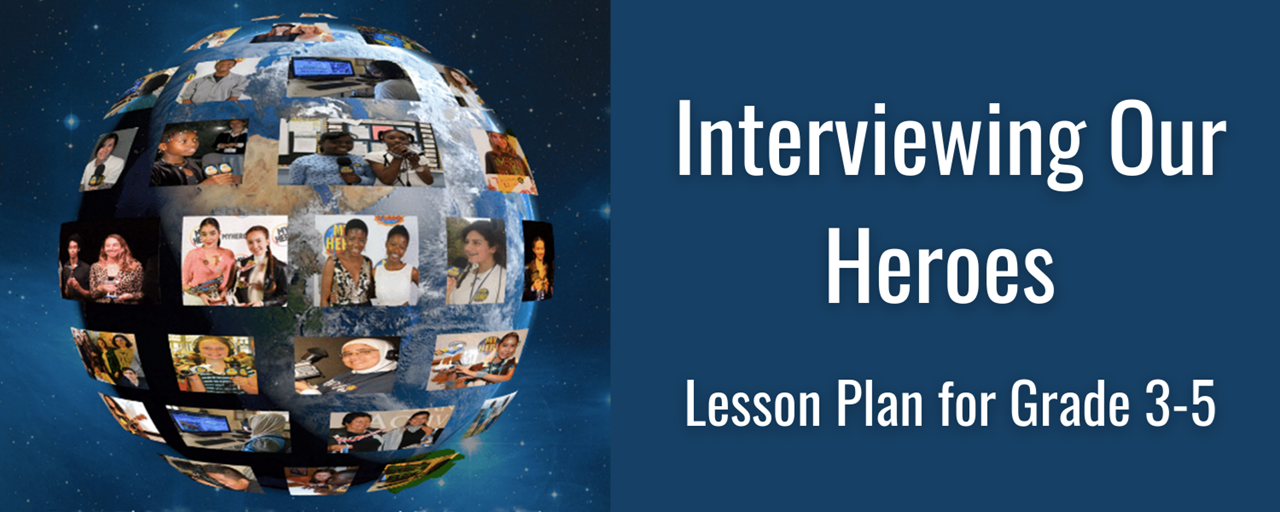Lesson Plan by Kyra Kirkwood, Robinson Elementary (Manhattan Beach, CA) and modified by Laura Nietzer, MY HERO Education Outreach Director. This lesson plan should take three class periods.

Overview/Purpose:
To teach third, fourth and fifth-grade students how to identify and effectively tell someone else's story using a newspaper article-type format.
Objectives:
Students will learn how to:
- seek out a hero-based story that interests them;
- conduct an in-depth interview;
- take detailed notes and decipher them;
- condense all their information down into concise newspaper-style articles and
- submit this story to the MY HERO website to have it published.
This lesson would be a great introductory lesson into the world of journalism. It is recommended to use it as the club's first assignment. Since it encourages them to interview people they know, this will warm up these "cub reporters" to interviewing others they don't know for articles to be published later in the club's newspaper.
Activities and Procedures:
A. Introduce the students to the MY HERO website (https://myhero.com) and explain what they will be doing (interviewing their own heroes, writing up the story, and posting it on the MY HERO website).
B. Have the students individually brainstorm to figure out who their heroes are and why. It needs to be someone they can talk to/interview, so sports pros and movie stars won't work for this project. Encourage the students to think about their lives, schools, families, and neighborhoods to find a "hometown hero" with a story to share.
C. Once the heroes are identified, have each child write down a series of 10 questions to ask them. These questions should cover the basic "who, what, when, where, why, and how" and help explain why the interviewee is deemed a hero. For example, if Johnny's hero is his uncle Bill who is a firefighter, Johnny could ask such questions as:
Why did you want to become a firefighter?
What is your favorite part of the job?
What was your scariest day on the job?
What keeps you coming back day after day?
How did you prepare to become a firefighter?
Where do you work?
Who is your on-the-job hero?
D. Check the students' questions, which can be written in longhand or typed on the computer. Tell them to make their interview appointments by a certain date (of your choosing). This is their first deadline. Explain to them the importance of meeting deadlines in the journalism world.
E. Talk about interviewing. Explain how an interview with someone is really just a conversation with a lot of listening and note-taking. Encourage them to ask more questions than are on their lists, if they feel compelled to do so.
F. Explain how note-taking is really just that: notes. The students don't have to write down every single thing the person says unless a direct quote is desired. If the interviewee says something clever, the student may wish to use that as a direct quote. That must be written down word for word. Show them examples of quotes from the daily paper or a reliable internet source. Encourage the students to ask their heroes to repeat things in order to accurately transcribe what was said.
G. Send them out with an assignment to bring their completed interviews back to class by a chosen due date.
_____________________________________________________________________________________________________
H. Second part of this lesson: Make sure the students will have their notes with them. They must have adhered to the deadline and already interviewed their heroes. Have them read through their notes one time to refresh their memories.
I. Students use a computer and word-processing program of your choice.
J. It's time to write the lead, or first, paragraph of their stories. A lead is the main point of the article. Share examples of a lead from news articles online or in a newspaper. Encourage each student to summarize, in one sentence, who their hero is and why. In other words, have them write down what makes this person so interesting. That is the lead. Have them revise it.
K. Then the students, using their notes, will continue writing. Each paragraph in the article will contain facts about these heroes learned from the interviews. Encourage the students to use quotes if they have them in their notes.
L. In their conclusion paragraphs, summarize once more why these people are heroes. Ending with a quote is nice, too.
M. Each student will then read their articles silently and fact-check them against their notes for accuracy. Then they will work on revising their article before editing to check for grammatical and spelling errors. Then they share it with their teacher. (You can grade them and then have them make corrections, for younger students you may have to assist them with their edits.)
N. Students make any corrections necessary.
O. Have students read through their article another time to make sure they are happy with the finished products and revise if necessary.
______________________________________________________________________________
P. Last Steps: Students register on MY HERO using the class code teachers have created. (Teachers should be a registered MY HERO educator and then create a class code to share with students to use as they register. See tutorials below for additional information.) Go around the room and make sure everyone is successfully registered.
Q. Once registered, students use the MY HERO Create program, to cut and paste their articles into the template. (See the tutorial below to share with students how to use the Create program to upload a story.)
R. Any photos submitted to MY HERO must be from the public domain or students have permission to use the image and gives proper credit.
S. When students are completely finished, have them click on Finish and then the "Submit" button on the window that will come up.
Tutorials for Students
Tutorials for Teachers
Organizer created on 4/28/2022 11:50:30 AM by Laura Nietzer
Last edited 4/28/2022 1:58:48 PM by Laura Nietzer